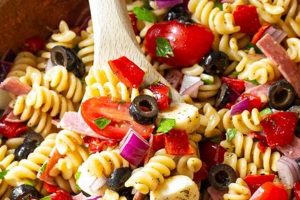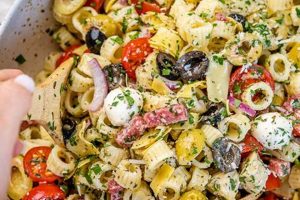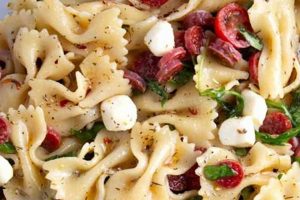Combinations of cooked pasta, canned tuna, and various other ingredients like vegetables, herbs, and dressings characterize this popular dish. A classic example includes shell pasta, tuna, celery, mayonnaise, and onion, offering a balance of protein, carbohydrates, and flavor.
This type of dish offers a convenient and nutritious meal option, adaptable to diverse dietary needs and preferences. Its versatility stems from the wide array of potential additions, from simple seasonings to more complex ingredient combinations. Historically, pasta salads gained popularity as refrigeration became more commonplace, allowing for safe storage and consumption of mayonnaise-based dishes. This convenience contributed to their emergence as a picnic staple and a frequent component of potlucks and casual gatherings.
Further exploration will encompass variations on the basic formula, addressing factors such as ingredient selection, dressing choices, and nutritional considerations. This will include insights into creating healthier versions, exploring global influences, and offering guidance on achieving optimal flavor profiles and textures.
Tips for Exceptional Tuna Pasta Salad
Achieving a flavorful and well-balanced tuna pasta salad requires attention to detail. These tips offer guidance on ingredient selection, preparation techniques, and flavor enhancement.
Tip 1: Opt for high-quality canned tuna. Tuna packed in oil typically offers a richer flavor and moister texture compared to tuna packed in water. Solid or chunk light tuna provides a substantial texture, while flaked tuna offers a finer consistency.
Tip 2: Cook pasta al dente. Slightly firm pasta holds its shape better in the salad and prevents a mushy texture. Rinse the cooked pasta under cold water to stop the cooking process and cool it down quickly.
Tip 3: Incorporate a variety of vegetables for added flavor and texture. Consider options such as chopped celery, bell peppers, red onion, or cherry tomatoes. Blanching or lightly steaming certain vegetables can enhance their flavor and color while maintaining a crisp texture.
Tip 4: Experiment with different dressings. While mayonnaise is a classic choice, consider incorporating Greek yogurt, sour cream, or vinaigrette for a lighter and tangier flavor profile. Freshly squeezed lemon juice can also brighten the overall taste.
Tip 5: Enhance the flavor profile with herbs and spices. Fresh dill, parsley, or chives complement tuna exceptionally well. A dash of black pepper, paprika, or garlic powder can add depth and complexity.
Tip 6: Chill the salad thoroughly before serving. Chilling allows the flavors to meld and enhances the overall enjoyment. Aim for at least 30 minutes of refrigeration time.
Tip 7: Consider adding other protein sources or textural elements. Hard-boiled eggs, chickpeas, or chopped nuts can add nutritional value and textural contrast.
By following these guidelines, one can elevate a simple tuna pasta salad to a culinary creation that balances flavor, texture, and visual appeal.
These considerations will lead into a concluding summary of the core principles discussed throughout this exploration of tuna pasta salad preparation.
1. Pasta Variety
Pasta variety significantly influences the overall character of a tuna pasta salad. Shape, size, and texture contribute to the dish’s ability to hold dressing, present appealing visuals, and deliver a satisfying mouthfeel. Small, tubular shapes like ditalini or elbow macaroni readily absorb dressing, resulting in a richly flavored salad. Larger, more complex shapes such as rotini, fusilli, or farfalle capture ingredients within their curves, creating textural interest. Shell pasta, with its concave form, offers similar advantages. Conversely, long, thin pasta like spaghetti or linguine, while suitable for other pasta dishes, typically proves less effective in pasta salads due to difficulties in achieving an even distribution of ingredients and dressing.
Consideration of pasta composition also contributes to a successful tuna pasta salad. Whole wheat pasta introduces a nutty flavor and denser texture, while gluten-free options cater to specific dietary needs. Fresh pasta, although less commonly used, offers a delicate texture that contrasts with the other ingredients. Matching the pasta variety to the desired outcome, whether a light and refreshing salad or a heartier, more substantial meal, represents a key decision in recipe development. For instance, a salad featuring robust vegetables like bell peppers and olives might benefit from a sturdy pasta like rotini, while a salad with delicate herbs and a light vinaigrette might pair well with smaller, more delicate shapes.
Appropriate pasta selection elevates tuna pasta salad from a simple combination of ingredients to a carefully considered culinary creation. This attention to detail ensures a balanced interplay of flavors, textures, and visual appeal. Choosing the right pasta provides a foundation for the other components, creating a harmonious and enjoyable dining experience. Challenges may include finding a balance between visual appeal and practicality, as some shapes, while visually interesting, might prove difficult to eat. Ultimately, understanding the role of pasta variety enables informed choices that contribute significantly to the success of the recipe.
2. Tuna Selection
Tuna selection significantly impacts the overall flavor profile and quality of tuna pasta salad. Different tuna varieties, packing methods, and quality grades offer distinct characteristics that influence the final dish. Solid or chunk light tuna, typically from skipjack, offers a firm texture and mild flavor, making it a versatile choice. Albacore tuna, often labeled “white meat tuna,” possesses a lighter color, firmer texture, and slightly more pronounced flavor. Yellowfin tuna, while less common in canned form, provides a richer, more robust flavor profile.
The packing medium also plays a crucial role. Tuna packed in oil, typically olive oil or vegetable oil, retains more moisture and exhibits a richer flavor compared to water-packed tuna. Oil-packed tuna contributes to a more luxurious mouthfeel in the salad. Water-packed tuna, while a leaner option, can sometimes result in a drier texture. Draining excess oil or water before incorporating the tuna into the salad helps prevent an overly oily or watery consistency. For a lighter flavor profile, consider rinsing the tuna before adding it to the salad. Conversely, reserving some of the oil from oil-packed tuna can enhance the dressing’s richness and flavor.
Understanding the nuances of tuna selection allows for informed choices that complement the other ingredients in the salad. Choosing high-quality tuna contributes to a more satisfying culinary experience. Challenges may include balancing cost considerations with desired flavor and texture preferences. For instance, while premium tuna varieties offer superior flavor, they typically come at a higher price point. Ultimately, careful tuna selection ensures that the final dish achieves the desired balance of flavor, texture, and overall quality.
3. Flavorful Additions
Flavorful additions constitute a critical component of successful tuna pasta salad recipes, transforming a simple combination of ingredients into a complex and satisfying dish. These additions contribute not only to taste but also to texture, visual appeal, and nutritional value. The strategic incorporation of vegetables, herbs, spices, and other complementary elements elevates the sensory experience and provides opportunities for customization based on individual preferences and dietary considerations.
Vegetables play a multifaceted role, adding crispness, color, and a range of flavors. Common choices include celery, red onion, bell peppers, and cucumbers, each contributing distinct textural and taste elements. Blanching or roasting certain vegetables prior to inclusion can intensify their flavors and offer nuanced textures. Herbs introduce aromatic complexity, with dill, parsley, chives, and mint complementing the tuna’s savory notes. Spices offer further depth, with black pepper, paprika, or cayenne pepper adding subtle heat or earthiness. Beyond vegetables and herbs, ingredients such as olives, capers, artichoke hearts, or sun-dried tomatoes introduce salty, briny, or tangy accents that enhance the overall flavor profile. Consider a Mediterranean-inspired tuna pasta salad with Kalamata olives, feta cheese, and a lemon-herb vinaigrette. The olives provide a salty, briny counterpoint to the tuna, while the feta cheese adds a creamy, tangy element. Alternatively, a Southwestern-inspired version might incorporate corn, black beans, jalapenos, and a cilantro-lime dressing for a vibrant and spicy twist. These examples demonstrate the transformative potential of flavorful additions in shaping distinct culinary experiences.
Understanding the interplay of these elements enables the creation of balanced and harmonious tuna pasta salads. Challenges may involve finding the right balance of flavors and textures to avoid overwhelming the palate or creating a disjointed culinary experience. Overuse of strong flavors, like raw onion or garlic, can overshadow the delicate flavor of the tuna. Similarly, incorporating too many textural elements can result in a confusing mouthfeel. Careful consideration of ingredient combinations ensures a cohesive and enjoyable culinary outcome, showcasing the versatility and adaptability of tuna pasta salad as a culinary canvas.
4. Dressing Choices
Dressing choices profoundly influence the overall flavor profile and character of tuna pasta salad. The dressing acts as a unifying element, binding the individual components and imparting a cohesive taste experience. A well-chosen dressing complements the flavors of the tuna, pasta, and other ingredients, creating a harmonious balance. The consistency of the dressing also impacts the salad’s texture, contributing to a creamy, tangy, or light and refreshing mouthfeel.
Classic mayonnaise-based dressings provide a creamy, rich texture and a tangy flavor that complements the savory notes of tuna. Variations can include the addition of Dijon mustard, lemon juice, or herbs for added complexity. Vinaigrettes, typically composed of oil and vinegar, offer a lighter, brighter alternative, enhancing the freshness of the vegetables and providing a contrasting acidity. Greek yogurt-based dressings provide a tangy, creamy texture with a lower fat content compared to traditional mayonnaise-based options. Flavor profiles can be further enhanced by incorporating ingredients such as garlic, herbs, spices, or citrus zest. For example, a lemon-dill vinaigrette provides a refreshing counterpoint to the richness of the tuna, while a creamy dressing infused with roasted red peppers adds a smoky sweetness.
Strategic dressing selection involves considering the desired outcome and the interplay of flavors. A robust, creamy dressing might overwhelm delicate ingredients, while a light vinaigrette may not provide sufficient cohesion for a salad with heartier components. Challenges include balancing flavor intensity, textural compatibility, and dietary considerations. Achieving the right balance ensures a harmonious and enjoyable sensory experience, transforming a simple tuna pasta salad into a culinary expression of creativity and flavor exploration.
5. Proper Chilling
Proper chilling constitutes a crucial step in preparing tuna pasta salad, significantly impacting food safety, flavor development, and overall textural quality. Chilling allows the flavors of the various ingredientstuna, pasta, vegetables, and dressingto meld and harmonize, creating a more cohesive and enjoyable culinary experience. Moreover, adequate chilling inhibits bacterial growth, ensuring food safety and preventing spoilage. Lower temperatures also enhance the structural integrity of the pasta and vegetables, preventing them from becoming mushy or losing their crispness.
Chilling tuna pasta salad for at least two hours before serving allows the flavors to fully develop and integrate. This resting period allows the dressing to permeate the pasta and other ingredients, resulting in a more balanced and flavorful dish. Furthermore, chilling firms the pasta, enhancing its texture and preventing it from becoming overly soft. From a food safety perspective, maintaining a temperature below 40F (4C) inhibits the growth of harmful bacteria, reducing the risk of foodborne illness. Conversely, leaving tuna pasta salad at room temperature for extended periods can promote bacterial proliferation, potentially leading to spoilage and health risks. For example, a pasta salad left unrefrigerated at a picnic or outdoor gathering on a warm day could become a breeding ground for bacteria, posing a significant health hazard. Proper chilling, therefore, represents a critical food safety practice.
Effective chilling practices contribute significantly to the overall quality and safety of tuna pasta salad. Understanding the importance of temperature control and allowing sufficient chilling time ensures optimal flavor development, desirable textural qualities, and safe consumption. Neglecting proper chilling can compromise both the sensory experience and food safety, potentially leading to undesirable outcomes. Challenges may include logistical considerations, such as access to refrigeration during transport or outdoor events. Utilizing insulated containers and ice packs helps maintain safe temperatures and preserves the quality of the salad in such situations. Prioritizing proper chilling techniques contributes to a more enjoyable and safe culinary experience.
Frequently Asked Questions
This section addresses common inquiries regarding tuna pasta salad preparation, offering concise and informative responses.
Question 1: What type of pasta works best in tuna pasta salad?
Shapes that hold dressing well, such as rotini, farfalle, or shells, are generally preferred. Avoid long, thin pasta like spaghetti, which can become difficult to manage in a salad.
Question 2: Can water-packed tuna be used instead of oil-packed?
While water-packed tuna is a leaner option, oil-packed tuna contributes a richer flavor and moister texture. If using water-packed tuna, consider adding a small amount of olive oil to compensate for the lack of oil.
Question 3: How long can tuna pasta salad be stored in the refrigerator?
Properly stored in an airtight container, tuna pasta salad typically remains safe to consume for three to five days in the refrigerator. Always check for signs of spoilage before consuming.
Question 4: What are some healthy alternatives to traditional mayonnaise-based dressings?
Greek yogurt, light mayonnaise, or vinaigrettes offer lower-fat and calorie alternatives while still providing creamy or tangy flavor profiles. Consider using a combination of these options for a balanced flavor.
Question 5: Can tuna pasta salad be frozen?
Freezing is generally not recommended, as mayonnaise-based dressings can separate and the vegetables can lose their texture upon thawing. It is best to prepare and consume tuna pasta salad fresh.
Question 6: How can one prevent the pasta from becoming mushy in tuna pasta salad?
Cooking the pasta al dente and rinsing it under cold water after cooking helps maintain its firmness. Adding the dressing shortly before serving also prevents the pasta from absorbing too much liquid and becoming soggy.
Understanding these key aspects of tuna pasta salad preparation helps ensure a successful and enjoyable culinary experience. Attention to ingredient selection, dressing choices, and proper storage contributes to a flavorful and safe dish.
This concludes the frequently asked questions section.
Tuna Pasta Salad Recipes
Exploration of tuna pasta salad recipes reveals a dish offering remarkable versatility and adaptability. Careful selection of pasta shape, tuna variety, and complementary ingredients significantly influences the final product’s flavor profile and textural complexity. Dressing choices, ranging from classic mayonnaise-based options to lighter vinaigrettes, further contribute to the dish’s character. Proper chilling techniques are essential for both food safety and optimal flavor development. Addressing common preparation inquiries provides practical guidance for achieving culinary success.
Consideration of these elements transforms tuna pasta salad from a simple combination of ingredients into a nuanced culinary creation. This adaptable dish offers a canvas for culinary exploration, accommodating diverse palates and dietary preferences. Continued experimentation with flavors and textures promises ongoing culinary innovation within this classic dish’s framework.






